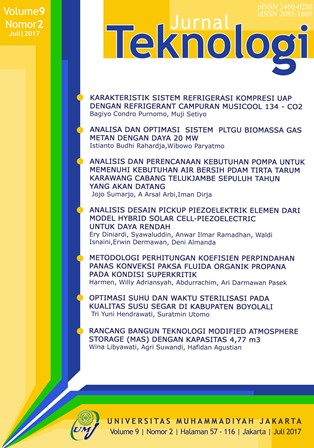OPTIMASI SUHU DAN WAKTU STERILISASI PADA KUALITAS SUSU SEGAR DI KABUPATEN BOYOLALI
Isi Artikel Utama
Abstrak
Unduhan
Rincian Artikel
COPYRIGHT POLICY
The author(s) of an article published in the Jurnal Teknologi retains ownership of the intellectual property rights in work (s).
PUBLISHING RIGHTS
The author(s) of an article published in the Jurnal Teknologi have unrestricted publication rights. The authors give the Jurnal Teknologi the right to publish the article and designate the Faculty of Engineering Universitas Muhammadiyah Jakarta Publishing as the original publisher of the article.
LICENSING POLICY
Journal of Mechanical Engineering and Sciences is an open-access journal that follows the Creative Commons Non-Commercial 4.0 International License (CC BY-NC 4.0), which states that:

Under this license, the reusers must give appropriate credit, provide a link to the license, and indicate if changes were made. Users may do so in any reasonable manner, but not in any way that suggests the licensor endorses users or their use.
Please take the time to read the whole license agreement (https://creativecommons.org/licenses/by-nc/4.0/). As long as reusers follow the license conditions, the owner cannot withdraw these freedoms. The following components are included under this license:
 Attribution: Users must provide appropriate attribution, including a link to the license, and indicate whether or not they made any modifications. Users are free to do so reasonably, but not in a manner that indicates the licensee approves of their usage.
Attribution: Users must provide appropriate attribution, including a link to the license, and indicate whether or not they made any modifications. Users are free to do so reasonably, but not in a manner that indicates the licensee approves of their usage.
 NonCommercial: Users may not use the material for commercial purposes.
NonCommercial: Users may not use the material for commercial purposes.
Referensi
Austin JE. 1992. Agroindustrial Project Analysis: Critical Design Factors. EDI Series in Economic Development. The Johns Hopkins University Press. Baltimore and London.
Branan CR. 1994. Rules of Thumb for Chemical Engineers, A Manual of Quick, Accurate Solutions to Everyday Process Engineering Problems. Gulf Publishing Company. Houston, Texas
Brown J G, Deloitte, Toache. 1994. Agroindustrial Investment and Operations. Washington DC : EDI Development Studies.
Chandan, R. C, 2011, Dairy Ingredients for Food Processing: Chapter 1. Dairy Ingredients for Food Processing: An Overview.
Dieter GE. 1987. Engineering Design, A Material and Processing Approach. First edition. McGraw-Hill Book Company. New York.
Douglas JM. 1998. Conceptual Design of Chemical Processes, Mc Graw Hill International Edition. Chemical Engineering Series.
Edgar TF and Himmelblau DM. 1988. Optimization of Chemical Processes, Chemical Engineering Series. Mc Graw Hill International Edition.
Gosta Bylund, MSc, 1995, Dairy Prosessing Handbook, Tetra Pak Processing Systems AB S-221 86 Lund, Sweden
Hadiwiyoto,S. 1982, Teknik Uji Mutu Susu dan Hasil Olahannya, Universitas Gajah Mada Press, Yogyakarta
http://www.azaquar.com/en/iaa/index.php?cible=ta_laiterie_03#_Toc222116729, diakses 28 Juni 2015
Lewis, M.J. dan Deeth, H. C. Milk Processing and Quality Management: Chapter 7. Heat Treatment of Milk. Edited by Dr Adnan Y. Tamime, Advance Dairy Science and Technology
Pisekey, J, 1997, Handbook of Milk Powder Manufacture, Copenhagen, Denmark
PT. Sari Husada Tbk, 2003, Proses Pengolahan Susu Bubuk, Yogyakarta
Saaty TL. 1993. Pengambilan Keputusan Bagi Para Pemimpin: Proses Hirarki Analitik untuk Pengambilan Keputusan dalam Situasi Yang Kompleks. Setiono L, penerjemah; Jakarta: Pustaka Binaman Presindo.Terjemahan.
Seider WD, Seader JD and Lewin DR. 1999. Process Design Principles Synthesis, Analysis and Evaluation. John Wiley & Sons, Inc.
Sinnott RK. 1989. Chemical Engineering, An Introduction to Chemical Engineering Design. Pergamon Press Oxford. New York.
SNI 3141.1.2011, BSN

